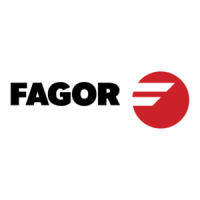Programming manual.
CNC 8070
STATEMENTS AND INSTRUCTIONS
22.
Programming statements
·389·
(REF: 1709)
22.1.6 ISO generation.
ISO generation converts canned cycles, calls to subroutines, loops, etc. into their equivalent
ISO code (G, F, S, etc functions), so the user can modify it and adapt it to his needs (eliminate
unwanted movements, etc.).
The CNC generates the new ISO code while simulating the program, either from the DISIMU
mode or from the conversational mode. Simulating a cycle from the cycle editor does not
generate ISO code. While converting into ISO code, the CNC saves the new blocks into a
new program (by default with extension .fiso) and, therefore, does not modify the original
program.
To generate the ISO code during simulation, the program must include the following
instructions. The CNC only generates the ISO code of the portion programmed between
these two instructions and it ignores the rest.
Programming. Enable ISO generation.
When defining this instruction, there is an option to define the path and the name of the
generated program. If a parameter is to be modified throughout the program, just program
the instruction again with the new parameters.
Programming format.
The programming format is the following; the arguments appear between curly brackets and
the optional ones between angle brackets. Programming the ON command is optional.
#ISO <ON> <[NAME="{path\name}"]>
Path and name of the generated file.
The path and name are optional; If not programmed, the CNC assumes the last value used
in the program. The CNC keeps the programmed values until the end of the program.
If the path is not indicated and no value has been programmed earlier, the generated program
will be in the same folder as the original one. If the name is not indicated and no value has
been programmed earlier, the generated program will have same name as the original one
but with the extension .fiso.
Original block. ISO generation.
ISO and conversational canned cycles. The CNC breaks up the canned cycles into ISO
blocks (G, F, S, etc. functions).
Local subroutines. The CNC replaces the calls to local
subroutines with the contents of the
subroutine.
Conditional loops ($IF, $FOR, etc.) and
block repetition (#RPT, NR).
The CNC breaks up the loops and repetitions
into ISO blocks (G, F, S, etc. functions).
Parameters and variables. The CNC replaces the arithmetic parameters
and variables with their values.
#ISO ON Enable ISO generation.
#ISO OFF Disable ISO generation.
NAME={path\name} Optional. Path and name of the output program.
#ISO
(Enable ISO generation)
#ISO ON [NAME="C:\Fagorcnc\Users\Prg\cycles.fiso"]
(Enable ISO generation)
(The CNC saves the program in the indicated folder)
(The CNC saves the program with the name "cycles.fiso")
#ISO [NAME="cycles.nc"]
(Enable ISO generation)
(The CNC saves the program with the name "cycles.nc")

